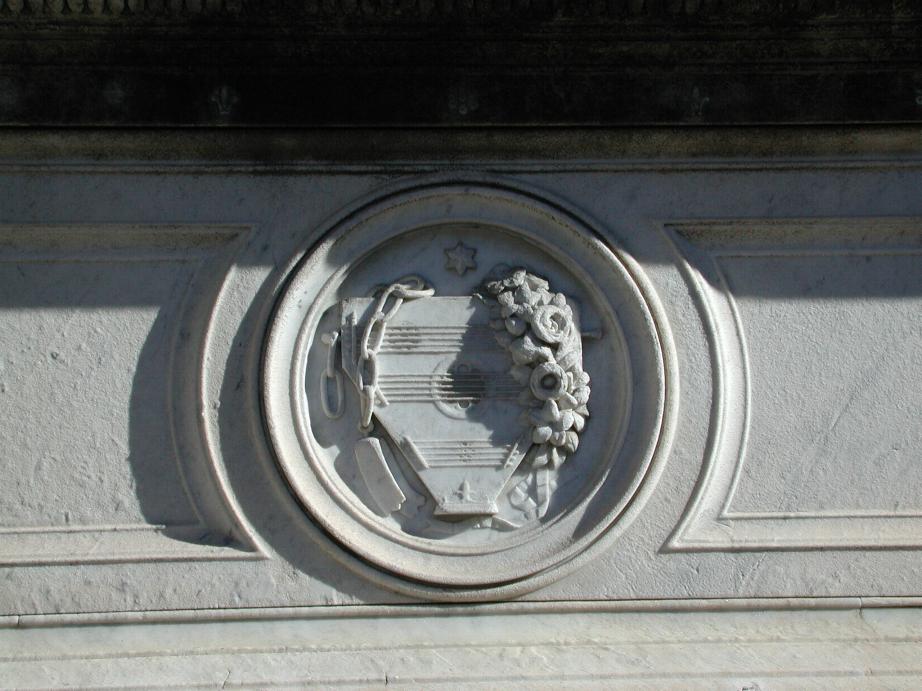trollope (original) (raw)
The Signora Neroni decides she will not be seen moving about as a cripple, but only arrayed in all her beauty, Madame Recamier-like, upon sofas. Like Elizabeth Barrett Browning, she writes innumerable sprightly letters from her couch. Also poetry in Italian, Novels in French. Bishop and Mrs Proudie summon the Stanhope family to dinner at the Palace. La Signora Neroni writes to Mr Slope explaining the need for the sofa. Which is accordingly placed in the large drawingroom at the top of the stairs. The bishop sits on it, is warned by his wife it is for a certain lady, his daughter, tittering, telling him the lady in question has no legs. Then 'La Signora Madeline Vesey Neroni' is announced. She is brought in head first, garbed in white velvet and pearls, and scarlet silk, by servants and siblings. Bishop Proudie, in conversation with Madeline's insufferable brother, Ethelbert, struggles to get around the sofa, his way blocked by a fat rector. Ethelbert attempts to help matters by pushing the sofa farther from the wall. But the rector has been leaning upon it and it now shoots away into the middle of the large drawing-room, where its castor caught up Mrs Proudie's
lace train, and carried away there is no saying how much of her garniture. Gathers were heard to go, stitches to crack, plaits to fly open, flounces were seen to fall, and breadths to expose themselves - a long ruin of rent lace disfigured the carpet, and still clung to the vile wheel on which the sofa moved . . . 'Oh you idiot, Bertie!' said the signora, seeing what had been done, and what were to be the consequences. . . . 'Unhand it, sir|' said Mrs Proudie. . . . 'Unhand it, sir!' said Mrs Proudie, with redoubled emphasis, . . . 'Unhand it, sir!', she almost screamed.

 'Poor white trash'
'Poor white trash'
 Clio
Clio
 Whitlaw visits the Steinmark Fatmily at Reichland
Whitlaw visits the Steinmark Fatmily at Reichland
 Edward Bligh witnessing racist cruelty
Edward Bligh witnessing racist cruelty
 Lucy at Mrs Shepherd's
Lucy at Mrs Shepherd's
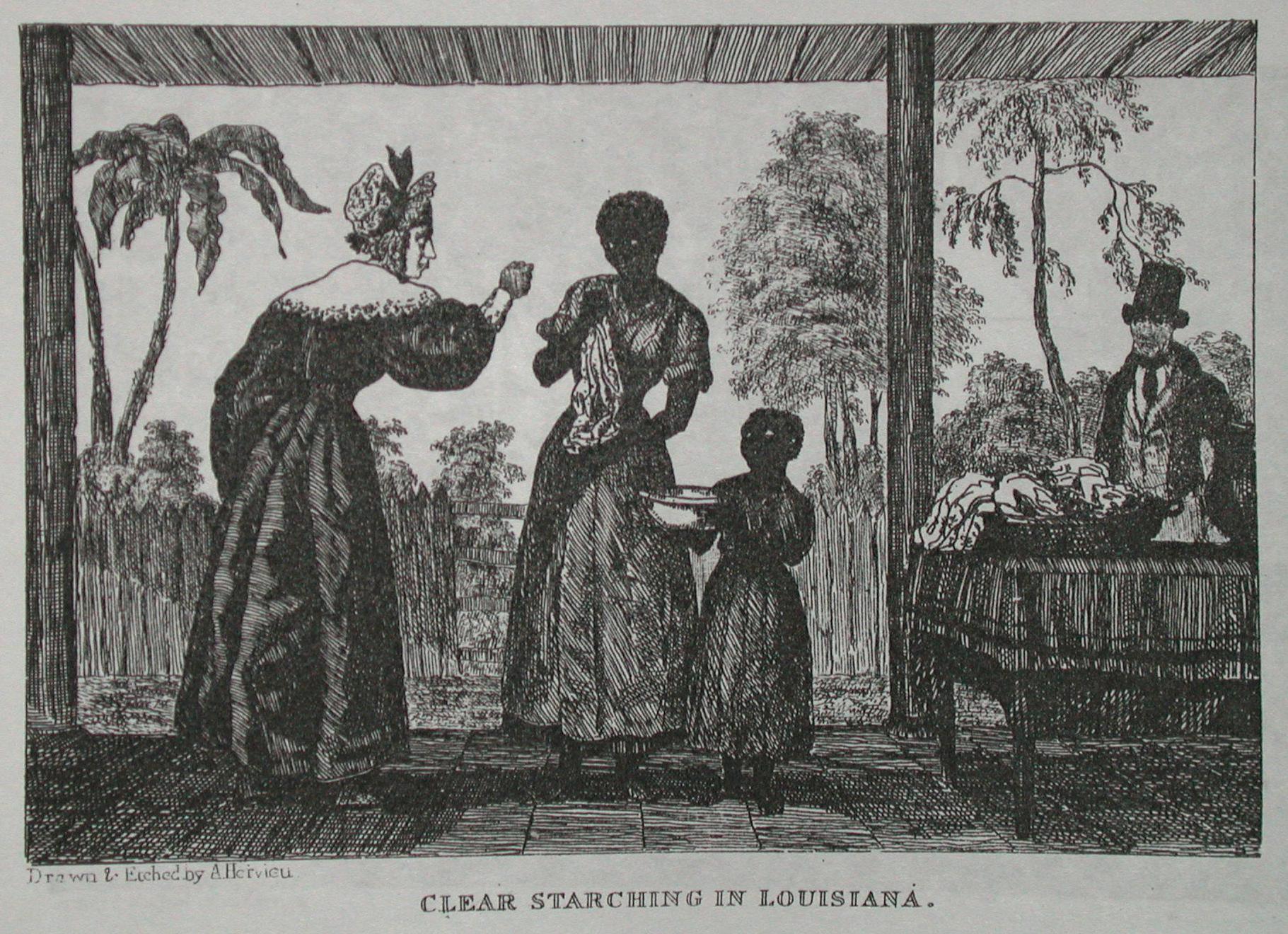 Servitude
Servitude
 Whitlaw
Whitlaw
 Phoebe, Peggy, Whitlaw, Caesar
Phoebe, Peggy, Whitlaw, Caesar
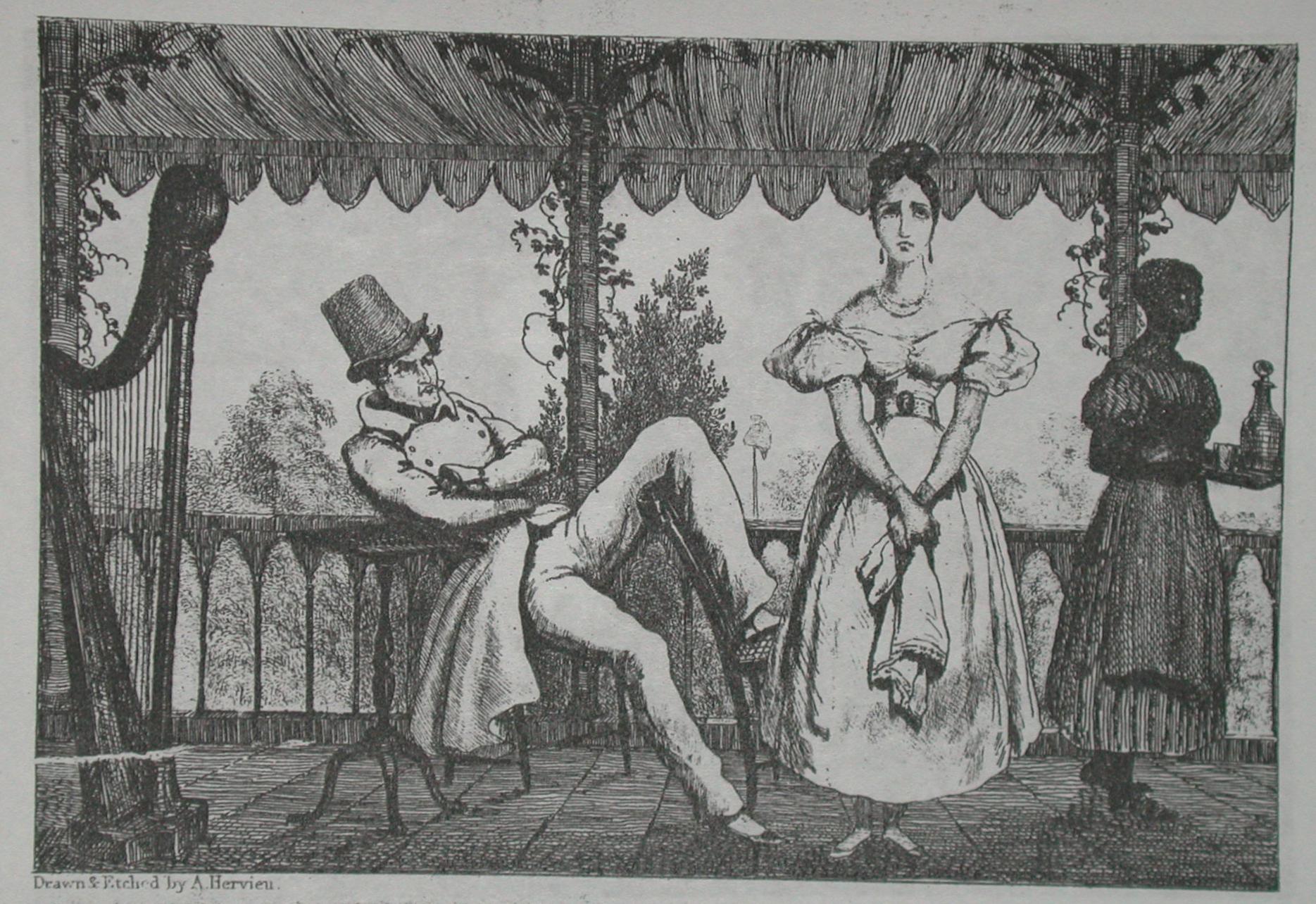 Whitlaw and Selina
Whitlaw and Selina
 Juno and Selina
Juno and Selina
 Lucy Bligh
Lucy Bligh
 Edward Bligh teaching slaves literacy
Edward Bligh teaching slaves literacy
 Edward Bligh lynched for teaching literacy
Edward Bligh lynched for teaching literacy
 Slaves kill Whitlaw
Slaves kill Whitlaw
She published Jonathan Jefferson Whitlaw or Life on the Mississippi in 1835. Already she had become famous for her Domestic Manners of the Americans, 1832. This first book she wrote to pay the family's debts. In it she describes Fanny Wright's Nashoba as a place of utter desolation, no schooling happening at all. Eventually Fanny Wright would ship these slaves to the free Republic of Haiti.

Fanny Trollope and her household travelled on to Cincinnati where she set up a Museum and a Bazaar. Hervieu set to work on a huge canvas on General Lafayette Landing in Cincinnati. While there she commissioned a young part Native American genius, named Hiram Powers, to sculpt Dante's Commedia in waxworks. We shall meet Hiram Powers again in this talk.
She did not like America. People spat tobacco into spittoons everywhere. She loathed slavery. She also disliked American sexual segregation.

On her way home she visited Niagara and Philadelphia. In Philadelphia she describes being allowed, during the Ladies Only Hour, to see plaster casts of nude statues. Here we see the Trollope's maid, Hester Rust, Fanny and her daughter Cecilia gazing at us! Or at least at Hervieu!

And the kind of plaster nudes they saw.
FANNY BACK HOME
The family then returned home to England.
In the late 1830s early 1840s Lord Ashley was preparing the groundwork for Parliamentary legislation against the abusive labour of children in factories and mines in England. He had asked Fanny to investigate and what she saw filled her with horror. Slave-owners did not kill or maim their slaves, keeping them alive. Factory and mine owners treated their child employees as expendable. Fanny saw conditions in England for English children as demonstrably worse than for slaves on American plantations.

Requested by Lord Ashley to write in support of his work for children in factories and mines, she published The Life and Adventures of Michael Armstrong, Factory Boy, in 1840. She and Hervieu actually travelled to the milltowns  and she and he together witnessed the most terrible scene in the book, where the starving children working in the mill steal from the pigs their swill.
and she and he together witnessed the most terrible scene in the book, where the starving children working in the mill steal from the pigs their swill.
THE TROLLOPES IN FLORENCE
Thomas Adolphus Trollope decided on setting up housekeeping in Florence with his mother, soon marrying the young Theodosia Garrow, Elizabeth Barrett Browning's tuberculor friend from her Torquay days. He acquired Villino Trollope, the corner building looking onto Florence's largest square, the Maria Antonia, now the Piazza Independenza. Here we see Thomas Adolphus, his now very aged mother, Fanny Trollope, his little daughter, Bice, for Beatrice, and the exotic Theodosia, granddaughter of an Indian princess, daughter of a Jewess.

Theodosia would die young and Thomas would marry Bice's governess, Dickens' mistress's sister. While Bice would marry a nobleman who at her death married Caroline, Millais' daughter. Villino Trollope was sold, but continued for many years as a boarding house, especially for writers. George Eliot wrote much of Romola here, and Thomas Hardy, Tess of the Durbervilles.We have five members of the Trollope household with us in Florence's 'English' Cemetery, Fanny, Theodosia, her father, Joseph Garrow, his stepdaughter, Harriet Fisher, and their much-loved maid, Elizabeth Shinner.
*� FRANCES (MILTON) TROLLOPE/ ENGLAND/ Trolloape [Trollope] nata Milton/ Vedova Francesca/ Guglielmo/ Inghilterra/ Firenze/ 6 Ottobre/ 1863/ Anni 84/ 849/ Fran�oise Veuve Trolloope, l'Angleterre, fille de Revd. Guillaume Milton, et de Marie, n�e Gressley, son �pouse/ FRANCESCAE TROLLOPE/ QUOD MORTALE FUIT/ HIC IACET/ . . . / MEMORIA/ NULLUM MARMOR QUAERIT/ APUD STAPLETON/ IN AGRO SOMERSET ANGLORUM/ A.D. 1780 NATA/ FLORENTIAE/ TUMULUM A.D.1863/ NACTA EST/ On the Trollopes in Florence, see Giuliana Artom Treves, Golden Ring, passim, � archival holdings; Thomas Adolphus Trollope writes the Latin of the inscriptions for his mother, his wife, his father-in-law; GL23777/1 N� 337 Burial 08/10 Age 84 Rev Pendleton / Thomas Adolphus Trollope, What I Remember, I & II/ NDNB entries for Trollopes, etc./ F11E

*� THEODOSIA (GARROW) TROLLOPE/ ENGLAND/ Trolloape [Trollope]/ Teodosia/ [Joseph Garrow]/ Inghilterra/ Firenze/ 12 Aprile/ 1865/ Anni 46/ 904**/+/** Theodosia Trollope, l'Angleterre/GL23777/1 N� 357 Burial 15/04 Age 46 Rev Pendleton; Marriage GL23774 N� 71+170/6 N� 71 03/04/48 Thomas Adolphus Trollope to Theodosia Garrow at HBM (Hamilton) bride d of Joseph Garrow, Devon, Rev Robbins; Baptism of child GL23775 N� 219/40, Beatrice Catherine Harriet 05/05/53, father Thomas Adolphus Esq, mother Theodosia, Rev O'Neill/ Thomas Adolphus Trollope, What I Remember, II.150-159, 166-168, & Chapter XVIII, who describes her as Florence's new Corinne; pp. 171-173. on her childhood friendship with Elizabeth Barrett Browning, both invalids to tuberculosis in Torquay/ NDNB entries for Theodosia Trollope, James Archibald Stuart-Wortley, whose grandson married first Theodosia's daughter, Bice, then Millais' daughter, Caroline/THEODOSIAE TROLLOPE/ T. ADOLFI TROLLOPE CONIUGIS/ QUOD MORTALE FUIT/ HIC IACET/ OBITUM EIUS FLEVERUNT OMNES/ QUANTUM AUTEM FERRI MERUIT/ VIR EUGUI SCRIPTORES/ SCIT SOLUS/ JOSEFE GARROW ARMr FILIA/ APUD TORQEW IN AGRORUM DEVON ANGLORUM NATA/ FLORENTIAE NOMEN AGENS LUSTRUM/ AD PLURES DIVINAE . . ./ MENSES APRILES A.D. 1865/ F11E/ See Fisher, Garrow, Trollope, Shinner

*� HARRIET THEODOSIA FISHER (GARROW)/ENGLAND/INDIA / Fischer/ Enrichetta Teodosia/ / Inghilterra/ Firenze/ 12 Novembre/ 1848/ Anni 37/ 393/ GL 23774 N� 26: Burial 14-11, Rev Robbins, Joseph Garrow's stepdaughter, Theodosia Garrow's half sister/ Thomas Adolphus Trollope, What I Remember, II.150-152, noting their mother was formerly a Miss Abrams and Jewish, who first married a naval officer, Fisher, then Joseph Garrow, whose own mother was East Indian; and that Harriet died of smallpox/ SACRED/ TO THE MEMORY OF/ HARRIET THEODOSIA FISHER/ STEP DAUGHTER OF JOSEPH GARROW/ OF BRADDONS TORQUAY DEVON ESQ/ WHO DIED UNIVERSALLY REGRETTED/ AT FLORENCE NOV 12 1848/ AGED 37 YEARS/ FOR ONE SO LOVING AND DUTIFUL/ OF GENEROUS COMPASSIONATE AND/ SELF DENYING LET US NOT WEEP AS THOSE WHO HAVE NO HOPE FOR/ WE KNOW THAT OUR BELOVED/ HAS RECEIVED HER REWARD/ D23G
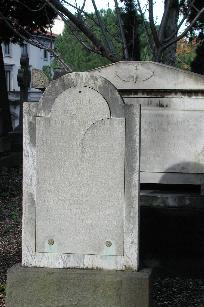
*� ELIZABETH SHINNER/ ENGLAND/ Shinner/ Elisabetta/ / Inghilterra/ Firenze/ 7 Ottobre/ 1852/ Anni 41/ 488/GL23774 N� 176 Burial 09/10, Rev M Slopper/ Maquay Diaries: 8 Oct 1852: �Mrs Burdett was to have spent today in the country with us but the death of her friend Mrs Tom Trollope�s favourite maid obliges her to remain with her.�/TO/ THE MEMORY OF/ ELIZABETH SHINNER/ WHO DIED/ OCT. 1852/ SHE WAS FOR MORE THAN/ TWENTY YEARS THE FAITHFUL/ SERVANT AND ATTACHED FRIEND/ OF THOSE WHO LAID HER BODY HERE/ [Pietra serena does not endure and an attempt has been made to repair this crumbling tomb]/ D22E

^*� JOSEPH GARROW/ INDIA/ Garrow/ +/ Giuseppe/ / Inghilterra/ Firenze/ 10 Novembre/ 1867 [1857]/ Anni 67/ 624/ Joseph Garrow, d'Angleterre/ / father of Theodosia Garrow-Trollope (12 Aprile/ 1865/ Anni 46/ 904/+/ F11E), stepfather of Harriet Theodosia Fisher (12 Novembre/ 1848/ Anni 37/ 393/ D23G, epitaph written by Thomas Adolphus Trollope). See Giuliana Artom Treves, Golden Ring, pp. 137/ GL23777/1 N�242, Burial 12/11, Rev O'Neill; marriage of child Theodosia 03/04/48 to Thomas Adolphus Trollope at HBM (Hamilton), Joseph Garrow, Harriet Fisher, Frances Trollope present, Rev Robbins/ Maquay Diaries: 13 Nov 1857/ Thomas Adolphus Trollope, What I Remember, II.150-159/ HIC JACET IOSEPHUS GARROW/ ARMr/ DE BRADDONS IN AGRO DEVON/ APUD INDOS NATUS/ A.D. 1789/ FLORENTIAN DENATUS/ A.D. 1857/ F12G/ See Theodosia Trollope, Harriet Fisher

This is the 'English' Cemetery, where Frances Trollope and Elizabeth Barrett Browning are buried, in a recent photograph, its oval having been designed at the Risorgimento by Giuseppe Poggi. Behind, to the center, you can see the studio of Michele Gordigiani who painted the famous portraits of Elizabeth Barrett and Robert Browning.
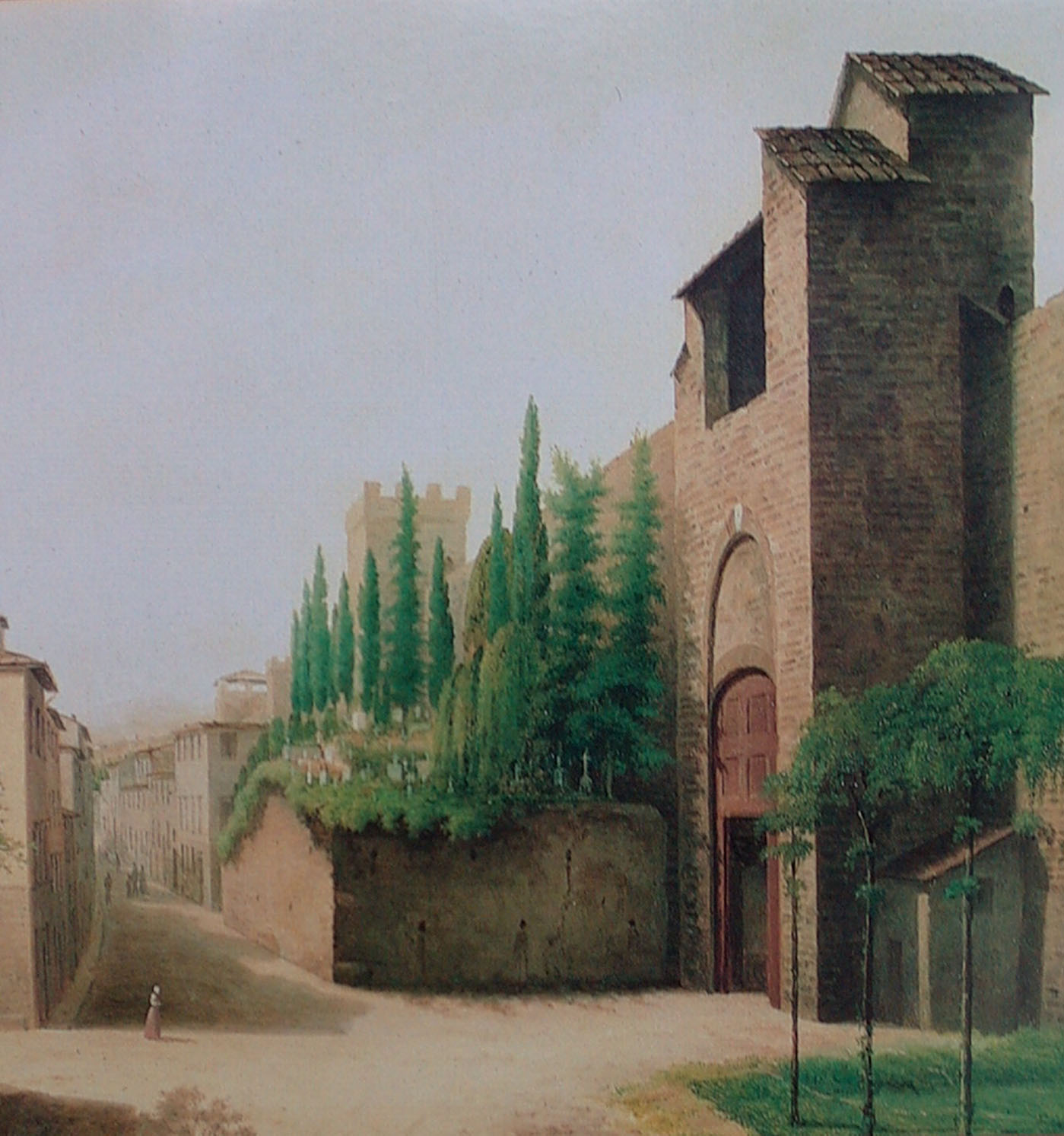
But when Elizabeth was buried here 1 July 1861, and Fanny in 6 October 1863, this is how the Cemetery then looked, nestled up against the great medieval wall built by Arnoldo di Cambio and Michelangelo that Poggi would later tear down.
FLORENCE AND FREEDOM
The English Cemetery, Florence's 'God's Acre' for foreigners, where Fanny Trollope and others of her household fittingly were laid to rest, is a nodal place, its monuments celebrating the writers of books, the sculptors of statues, who hated slavery and child abuse with a passion and who all interconnect. Fanny wrote the first anti-slave novel with Jonathan Jefferson Whitlaw, the American Richard Hildreth wrote the second one, The Slave, publishing it within six months of hers. Hildreth is buried near his fellow Unitarian Theodore Parker. Parker had preached so passionately against slavery that Frederick Douglass, who liked to visit the tombs of famed Abolitionists, came straight from the railroad station to it. While Harriet Beecher Stowe's Uncle Tom's Cabin, 'the little book that started the great war', Abraham Lincoln said, is cribbed from both Fanny Trollope's and Richard Hildreth's anti-slavery novels.


Lord Ashley, who became Lord Shaftesbury, worked with Southwood Smith on this campaign. And Southwood Smith came to be buried here, his medallion bust sculpted by Joel Hart, the American. On that team was also Richard Hengist Horne, who later emigrated to Australia.
Elizabeth Barrett Moulton Barrett had composed 'The Cry of the Children' for Hengist Horne, which was read in the House of Lords, influencing legislation to protect children working in factories and mines, and translated into Russian by Dosteivsky's brother Mikhail. When Elizabeth heard that Hengist Horne was bald, she decided he was not marriageable. What would one make of a bald Hamlet, she wrote. Leaving the door ajar for Robert Browning. Hengist Horne had Elizabeth Barrett work with him on A New Spirit of the Age. The first essay in the collection is a full length study of Southwood Smith who advocated the use of fresh air and sunlight and slum clearance, like his granddaughter, Octavia Hill, whom he had raised, and who came to be buried in Florence's 'English' Cemetery under a fine obelisk. Other essays in that two volume collection included those on Elizabeth Barrett, Robert Browning, Alfred Tennyson, Fanny Trollope. Most of these were accompanied by signed portrait engravings. Elizabeth had those of Browning and Tennyson framed and placed on her Wimpole Street mantelpiece. She proposed marriage to both of them, not having met either of them, in her Lady Geraldine's Courtship. Robert accepted and whenever he came a'courting she instructed her brothers to turn both portraits to the wall. Later, she would bring those framed engravings to Casa Guidi in Florence where they were placed on the mantelpiece.
Reader, she married him, 12 September 1845. His similar slave-owning family came from St Kitts. The couple immediately fled England for Italy, settling in Florence where she died 15 years later. Elizabeth knew she was herself part Black from her slave-trading Moulton grandfather. She guessed that Robert was part Jewish, praising his Bells and Pomegranates as from Aaron's High Priestly robe.



The first Duke of Florence, Alessandro de' Medici,


whose bones lie in one of the two tombs sculpted by Michelangelo, the one to Lorenzo, Duke of Urbino, his supposed father, the one that has the statues of Dusk and Dawn, was himself the son of Simonetta, a black slave. But his father was more probably Lorenzo's brother, Giulio de' Medici who became Pope Clement VII. For this reason, among others, I believe, Florence became a place of openness, of tolerance, and of immense creativity. So many who knew each other eventually came to live and to die in Florence and be buried here, among them Elizabeth Barrett Browning, Frances Trollope, her daughter-in-law Theodosia Trollope, Southwood Smith, Hiram Powers, Maurice Baruch, and Isa Blagden. They turned, by the alchemy of poetry and sculpture, the iron chain of slavery, the barrier of discimination, into the golden ring of freedom.
Robert, meanwhile, furnished the vast room in Florence in which Elizabeth wrote (and which she said was 'like a room in a novel') with antiques, including its great gold-framed mirror, and paintings, many pieces resulting from the suppression of monasteries, bought in San Lorenzo Market where, one day, he found 'The Old Yellow Book' about a man's murder of his wife. I have argued elsewhere that Robert may have been responsible for Elizabeth's death.
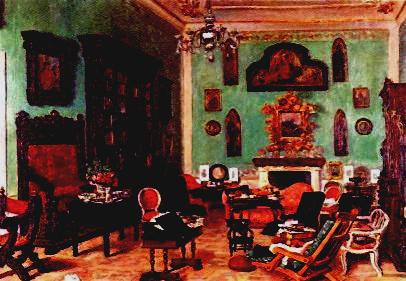
Robert and their son Pen Browning, Isa Blagden and Robert Lytton, who would become Viceroy of India, the Trollopes, the Powers, Kate Field and many others were present on that day at her graveside, but not Walter Savage Landor, as they forgot to send a carriage for the old mad King-Lear-like poet. Robert Browning never again visited her grave side, indeed interfered with the very beautiful tomb Frederic Lord Leighton designed for her, Robert seeing to it that her name was not present on it, only her initials, and that the intended portrait became as unlike hers as was possible.

 Leighton, however, paid tribute to Elizabeth's passion for the Abolition of Slavery by showing in marble a broken slave shackle of iron.
Leighton, however, paid tribute to Elizabeth's passion for the Abolition of Slavery by showing in marble a broken slave shackle of iron.

Leighton Sketch Book, Royal Academy Library
__
__
Greek Lyre Christian Harp Hebrew Harp
Tragedy and Comedy Cross Jubilee with Broken Slave Shackle

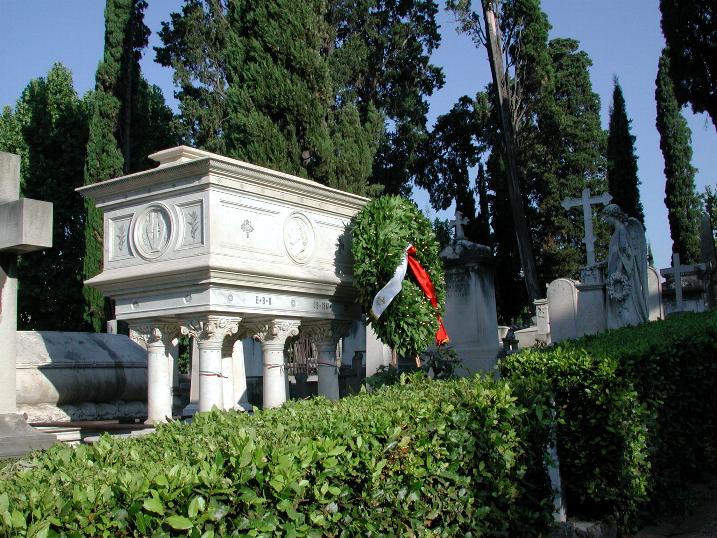
Indeed, several of the ex-patriot women of the Anglo-Florentine circle came of mixed blood, different colours and other faiths, being therefore scarcely marriageable in English society. Elizabeth herself had referred to her part slave ancestry. Maurice (Mois�) Baruch, the conscientious librarian of the English Church in Florence, found his resting place in the English Cemetery, buried by the Anglican Reverend Tottenham, his tomb inscribed in English and in German, the latter in fraktura script in 1867. Thomas Adolphus Trollope in What I Remember noted that the Hungarian patriot Ferencz Pulszky's talented beautiful Viennese wife, Therese Walther, was Jewish. While Thomas Adolphus' friend, Isa Blagden, and his own wife, Theodosia Garrow Trollope, were part Jewish, part East Indian. Nathaniel Hawthorne creates a composite of these in the exotic and beautiful character of Miriam in The Marble Faun.
There were . . . stories about Miriam�s origin and previous life . . . It was said, for example, that Miriam was the daughter and heiress of a great Jewish banker, (an idea perhaps suggested by a certain rich Oriental character in her face,) and had fled her paternal home to escape a union with a cousin, the heir of another of that golden brotherhood; the object being to retain their vast accumulation of wealth within the family . . . According to a[nother] . . ., she was the offspring of a Southern American planter, who had given her an elaborate education and endowed her with his wealth; but the one burning drop of African blood in her veins so affected her with a sense of ignominy, that she relinquished all and fled her country . . .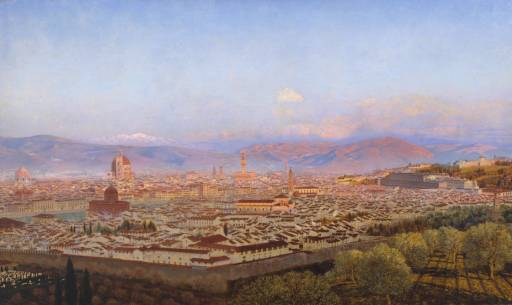
Elizabeth Barrett Browning described Isa Blagden's hospitable home in Bellosguardo with its view down upon Florence as that for her heroines, Aurora Leigh and Marian Erle. Henry James likewise delighted in visiting this vibrant exotic hostess. John Brett's fine painting from Isa's balcony includes the medieval walls as they were then, and huddled outside of them, the Jewish Cemetery.

Robert Lytton, who had attended Elizabeth's funeral along with Isa, was the son of Edward Bulwer-Lytton, had published poetry under the name of 'Owen Meredith' and became Viceroy of India.

Elizabeth had hoped Lytton would marry Isa Blagden, for she had saved his life one summer in Bagni di Lucca, when the Brownings were also there, but Isa's mixed blood, part Jewish, part East Indian, prevented the match. They both wrote works about their romance: Lytton's Lucile, a kind of Aurora Leigh, in verse; Isa's Agnes Tremorne in prose. I am hoping someone will write a book about Isa and Lytton.
In Florence, because of its openness, both English and Americans could be friends of each other more readily than could have been the case in either England or in America. Among Florence's residents was Hiram Powers, Fanny's Cincinnati proteg�, whose sculpture, the 'Greek Slave' was the very centre of the 1851 Crystal Palace Exhibition,
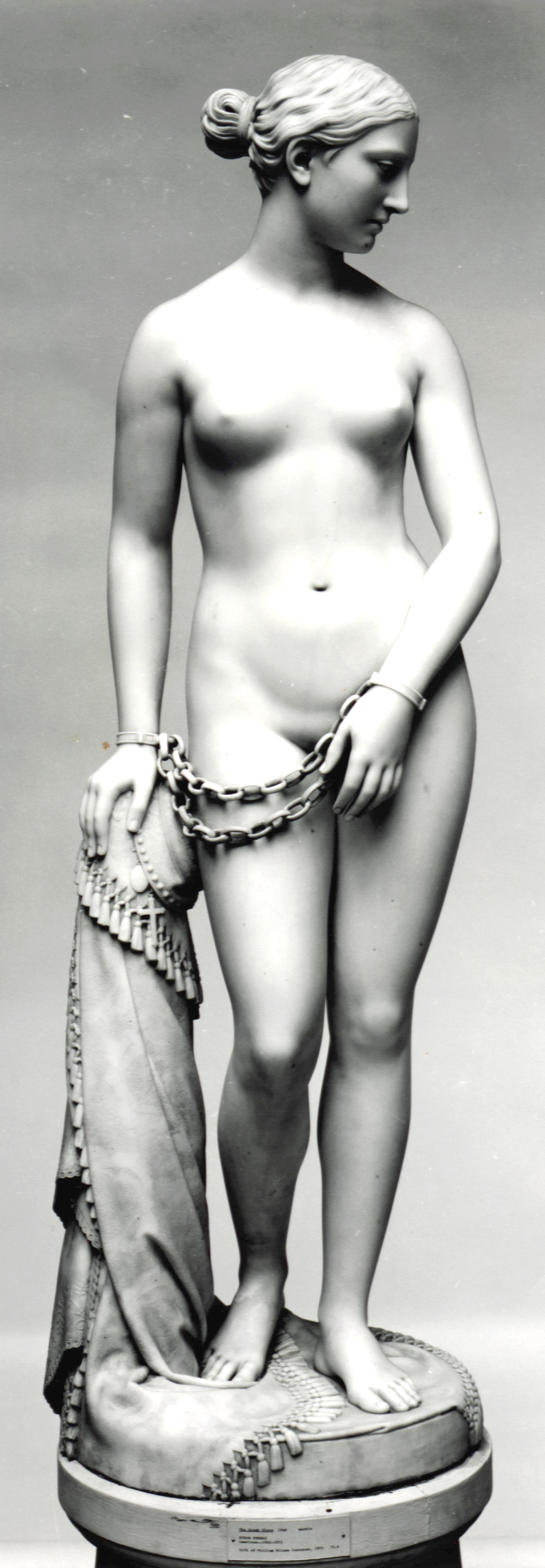
In the Collection of the Corcoran Gallery of Art. Gift of William Wilson Corcoran.whose 'America' was not accepted by Congress because he showed her trampling on slave chains,

and whose 'Last of Her Tribe' is exquisite.


He was himself part Native American and Elizabeth speaks of his great flashing eyes, while the brilliant artist Sophia Peabody, married to Nathaniel Hawthorne, studied sculpture under him.

Elizabeth Barrett Browning saw his sculpture of the 'Greek Slave' in his studio in Florence and was so moved by it that she wrote this sonnet.

In the Collection of the Corcoran Gallery of Art. Gift of William Wilson Corcoran.
They say Ideal Beauty cannot enter
The house of anguish. On the threshold stands
An alien Image with the shackled hands,
Called the Greek Slave: as if the sculptor meant her,
(That passionless perfection which he lent her,
Shadowed, not darkened, where the sill expands)
To, so, confront men�s crimes in different lands,
With man�s ideal sense. Pierce to the centre,
Art�s fiery finger! � and break up erelong
The serfdom of this world! Appeal, fair stone,
From God�s pure heights of beauty, against man�s wrong!
Catch up in thy divine face, not alone
East griefs but west, - and strike and shame the strong,
By thunders of white silence, overthrown!
Elizabeth is speaking here against slavery in America, in Russia. She and Fanny, though they did not like each other, share in so many ideals.
Buried also in our Swiss-owned so-called 'English' Cemetery, among servants from England, serfs from Russia, is also Nadezhda, whose name means 'Hope', who came at 14 to Florence, a Black slave from Nubia, who was baptized in a Russian Orthodox family and who lies beneath a most beautiful Orthodox cross in white marble, her story told in Cyrillic on its base. Pushkin, who wrote of a friend as buried under the sweet myrtle of Italy at Leghorn, was himself the grandson of 'Tsar Peter's Negro'.

'Zdes' pokoitsja telo/ negritjanki Kalimy/ vo Sv. Kresenii/ Nadezdy/ privezennoj vo Florenciju iz Nubii/ v 1827 godu . . . 1851// Primi mja Gospodi/ vo Carstvie Tvoe'/Qui giacciono le spoglie mortali della nera Kalima, nel Santo/ Battesimo chiamata Nadezda (Speranza) che � stata portata a Firenze dalla Nubia nel 1827 . . 1851, Accoglila Signore nel Tuo Regno/Thus Fanny and four other members of the Trollope household came to rest in the Swiss-owned English Cemetery in Florence. Among like-minded individuals in praise of freedom.
****FLORIN WEBSITE A WEBSITE ON FLORENCE � JULIA BOLTON HOLLOWAY, AUREO ANELLO ASSOCIAZIONE, 1997-2024: ACADEMIA BESSARION || MEDIEVAL: BRUNETTO LATINO, DANTE ALIGHIERI, SWEET NEW STYLE: BRUNETTO LATINO, DANTE ALIGHIERI, & GEOFFREY CHAUCER || VICTORIAN : WHITE SILENCE: FLORENCE'S 'ENGLISH' CEMETERY || ELIZABETH BARRETT BROWNING || WALTER SAVAGE LANDOR || FRANCES TROLLOPE || ABOLITION OF SLAVERY || FLORENCE IN SEPIA || CITY AND BOOK CONFERENCE PROCEEDINGS I, II, III,IV,V,VI,VII , VIII, IX, X || MEDIATHECA 'FIORETTA MAZZEI' || EDITRICEAUREO ANELLO CATALOGUE || UMILTA WEBSITE || LINGUE/LANGUAGES: ITALIANO,ENGLISH || VITA** New: Opere Brunetto Latino || Dante vivo || White Silence
